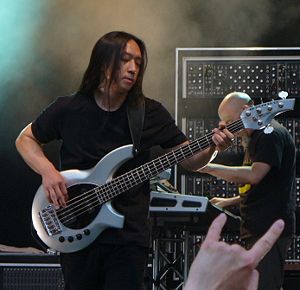
Music Man is an American guitar and bass guitar manufacturer. It is a division of the Ernie Ball corporation. The company is most well-known for its electric and bass guitars. Determined to maintain a reputation for quality, the Music Man company largely produces high-end guitars, especially after being acquired by Ernie Ball in 1984.
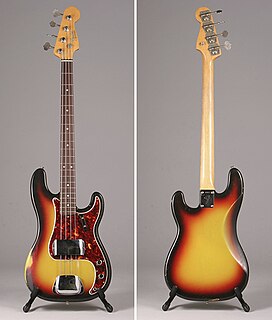
The Fender Precision Bass is a model of electric bass manufactured by Fender Musical Instruments Corporation. In its standard, post-1957 configuration, the Precision Bass is a solid body, four-stringed instrument equipped with a single split-coil humbucking pickup and a one-piece, 20-fret maple neck with rosewood or maple fingerboard.
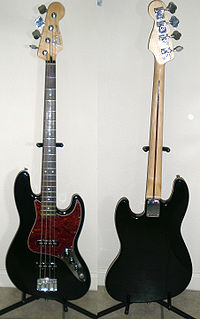
The Fender Jazz Bass is the second model of electric bass created by Leo Fender. It is distinct from the Precision Bass in that its tone is brighter and richer in the midrange and treble with less emphasis on the fundamental frequency. The body shape is also different from the Precision Bass, in that the Precision Bass has a symmetrical lower bout on the body, designed after the Telecaster and Stratocaster lines of guitars, while the Jazz Bass has an offset lower bout, mimicking the design aesthetic of the Jaguar and Jazzmaster guitars.

A pickup is a transducer that captures or senses mechanical vibrations produced by musical instruments, particularly stringed instruments such as the electric guitar, and converts these to an electrical signal that is amplified using an instrument amplifier to produce musical sounds through a loudspeaker in a speaker enclosure. The signal from a pickup can also be recorded directly.

Parker Guitars was an American manufacturer of electric and acoustic guitars and basses, founded by luthier Ken Parker in 1993. Parker guitars were distinguished for their characteristic light weight and the use of composite materials.

Mason Bernard guitars are primarily stratocaster-style solid body electric guitar and electric acoustics made from 1990 to 1992 by Bernie Rico, the founder of B.C. Rich, and feature the "M Bernard" branding on the headstock. It is believed that about 225 guitars were made, but there are examples of Mason Bernard guitars with serial numbers as high as 352 and at least one acoustic model has been discovered in the wild.

The Squier '51 is an electric guitar made by Squier, a subsidiary of Fender. The '51 is notable for being one of the few original designs made by Squier, which normally manufactures less expensive authorized copies of Fender's popular guitars and bass guitars.
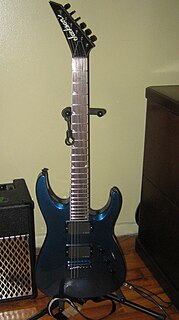
The Jackson Dinky is a Superstrat-style double-cutaway electric guitar built by Jackson Guitars. The "Dinky" is named for its slightly smaller than normal (7/8) body size. Usually fitted with a two humbucker pickup configuration, some models also include single-coil pickups and/or just one bridge humbucker. The fretboard can be made out of ebony, rosewood and more recently maple, or rock maple, with 24 jumbo frets and is always built with a bolt-on neck. Most of the guitars have a Floyd Rose original or licensed tremolo, and a locking nut to help maintain stable tuning. Some Dinkys have hardtail, or String-Thru bridges. The Jackson Dinky is usually preferred by players of hard rock and heavy metal.

The Fender Jaguar Bass is an electric bass guitar manufactured in Japan and China by the Fender Musical Instruments Corporation.
Music Man StingRay is an electric bass by Music Man, introduced in 1976.
The Music Man Sterling is a model of bass guitar designed by the Music Man company. Production for the model began in July 1993 though a series of pre-launch prototype models date back as far as March, 1993. It was named after Sterling Ball, son of Ernie Ball, the founder of the parent company, and intended to be a four-string model that incorporated innovations from the highly popular StingRay 5.
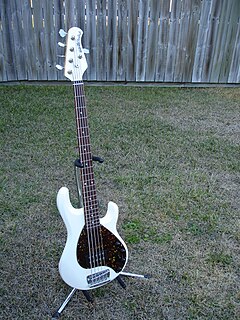
Introduced in 1987, the StingRay 5 (SR5) was the first all-new Music Man bass designed and built in San Luis Obispo by the Ernie Ball team. The five-string's styling is based on the classic look of the Silhouette guitar. Advanced active electronics combine the best of the four-string StingRay along with innovations from Music Man designers, such as an Alnico humbucking pickup and three-way pickup selector for series, single and parallel combinations. The tuners are placed in a 4+1 configuration and the six-bolt on maple neck has a rosewood or maple fingerboard with 22 high-profile wide frets.
The Fender Bullet was an electric guitar originally designed by John Page and manufactured and marketed by the Fender Musical Instruments Corporation. It was first introduced as a line of "student" guitars to replace the outgoing Mustang and Musicmaster models.

Starcaster by Fender' is a range of instruments and accessories aimed at students and beginners, marketed by the Fender Musical Instruments Corporation from the early 2000s until at least 2011. As of April 2018, no products were being marketed under this brand.
The musical equipment used by the members of Rush have changed many times over the years. The following is a catalog of the gear they have used or are currently using.

The Parker Fly was a model of electric guitar built by Parker Guitars. It was designed by Ken Parker and Larry Fishman, and first produced in 1993. The Fly is unique among electric guitars in the way it uses composite materials. It is notable for its light weight and resonance. It was also one of the first electric guitars to combine traditional magnetic pickups with piezoelectric pickups, allowing the guitarist to access both acoustic and electric tones. Production ended in 2016 and the company has not released a new model of any kind since.
Ken Lawrence Instruments is a manufacturer of custom guitars and bass guitars founded by Ken Lawrence in 1986. Besides building instruments, Lawrence has also performed as a bassist both live and in recording sessions. Lawrence began building instruments in 1981 at Moonstone Guitars, and five years later, he set up his own company.
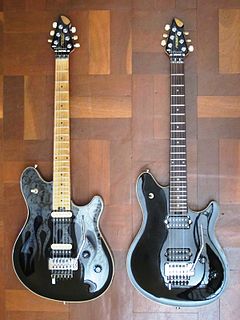
The Peavey EVH Wolfgang guitar series is the result of the collaboration between guitarist Edward Van Halen and Hartley Peavey's company, Peavey Electronics.
The Yamaha Corporation is a multinational corporation and conglomerate based in Japan with a wide range of products and services, predominantly musical instruments, motorcycles, power sports equipment and electronics.
The Fender Telecaster, colloquially known as the Tele, is the world's first mass-produced, commercially successful solid-body electric guitar. Its simple yet effective design and revolutionary sound broke ground and set trends in electric guitar manufacturing and popular music. Introduced for national distribution as the Broadcaster in the autumn of 1950 as a two-pickup version of its sister model, the single-pickup Esquire, the pair were the first guitars of their kind manufactured on a substantial scale. A trademark conflict with a rival manufacturer's led to the guitar being renamed in 1951. Initially, the Broadcaster name was simply cut off of the labels placed on the guitars and later in 1951, the final name of Telecaster was applied to the guitar to take advantage of the advent of television. The Telecaster quickly became a popular model, and has remained in continuous production since its first incarnation.
